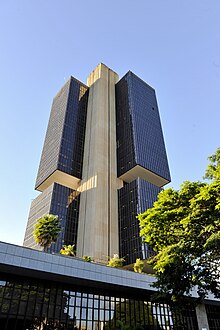
Back بنك البرازيل المركزي Arabic Bancu Central de Brasil AST Braziliya Mərkəzi Bankı Azerbaijani Централна банка на Бразилия Bulgarian ব্রাজিলের কেন্দ্রীয় ব্যাংক Bengali/Bangla Zentralbank von Brasilien German Centra Banko de Brazilo Esperanto Banco Central de Brasil Spanish بانک مرکزی برزیل Persian Banque centrale du Brésil French
 | |
 Headquarters | |
| Headquarters | SBS, Quadra 03, Bloco B Brasília, Federal District |
|---|---|
| Coordinates | 15°48′11″S 47°53′08″W / 15.80306°S 47.88556°W |
| Established | 31 December 1964 |
| Ownership | 100% independent[1] |
| President | Gabriel Galípolo |
| Central bank of | Brazil |
| Currency | Brazilian real BRL (ISO 4217) |
| Reserves | |
| Interest rate target | 12.25%[3] |
| Website | www |

The Central Bank of Brazil (Portuguese: Banco Central do Brasil, pronounced [ˈbɐ̃ku sẽˈtɾaw du bɾaˈziw]) is Brazil's central bank, the bank is autonomous in exercising its functions, and its main objective is to achieve stability in the purchasing power of the national currency. It was established on Thursday, 31 December 1964.
The bank is not linked to any ministry, currently being autonomous. Like other central banks, the Brazilian central bank is the principal monetary authority of the country. It received this authority when it was founded by three different institutions: the Bureau of Currency and Credit (SUMOC), the Bank of Brazil (BB), and the National Treasury.
One of the main instruments of Brazil's monetary policy is the Banco Central do Brasil's overnight rate, called the SELIC rate.[4] It is managed by Monetary Policy Committee (COPOM) of the bank.[5]
The bank is active in promoting financial inclusion policy and is a leading member of the Alliance for Financial Inclusion. It is also one of the original 17 regulatory institutions to make specific national commitments to financial inclusion under the Maya Declaration.[6] during the 2011 Global Policy Forum in Mexico.
Since 25 February 2021, it is independent from the Federal Government.[7]
- ^ Pooler, Michael; Harris, Bryan (11 February 2021). "Brazil passes law giving autonomy to central bank". Financial Times. Retrieved 21 September 2022.
- ^ "Detalhamento do Gráfico – Reservas Internacionais". Banco Central do Brasil (in Brazilian Portuguese). Retrieved 15 January 2025.
- ^ Carmo, Wendal (11 December 2024). "Copom acelera alta e leva Selic a 12,25% ao ano, a 2ª maior taxa real de juros no mundo". Carta Capital (in Brazilian Portuguese). Retrieved 11 December 2024.
- ^ Global, IndraStra. "The Central Bank of Brazil Maintains Selic Rate at 6.5%". IndraStra. ISSN 2381-3652.
- ^ "Banco Central do Brasil". bcb.gov.br. Retrieved 2018-06-23.
- ^ "Maya Declaration Urges Financial Inclusion for World's Unbanked Populations — RIVIERA MAYA, Mexico, Sept. 30, 2011/PRNewswire-USNewswire/". Archived from the original on 2011-10-04.
- ^ "Autonomia do Banco Central é sancionada". Banco Central do Brasil (in Brazilian Portuguese). 25 February 2021. Retrieved 30 June 2022.